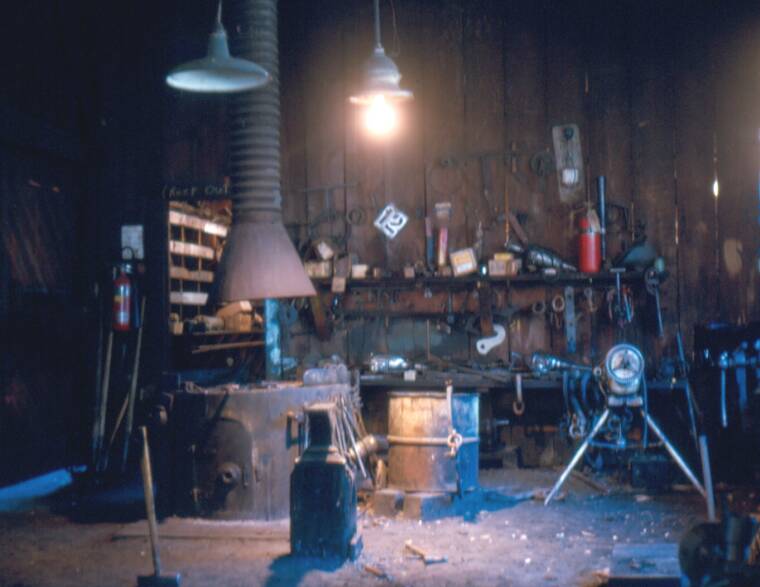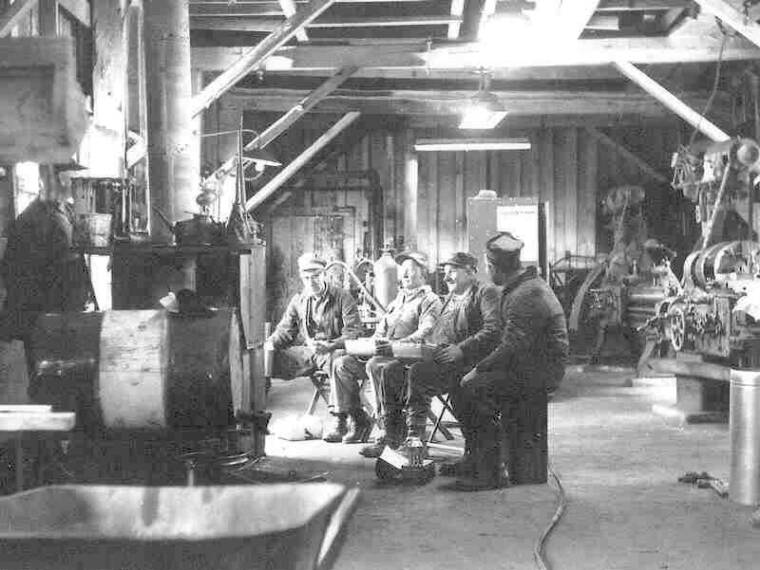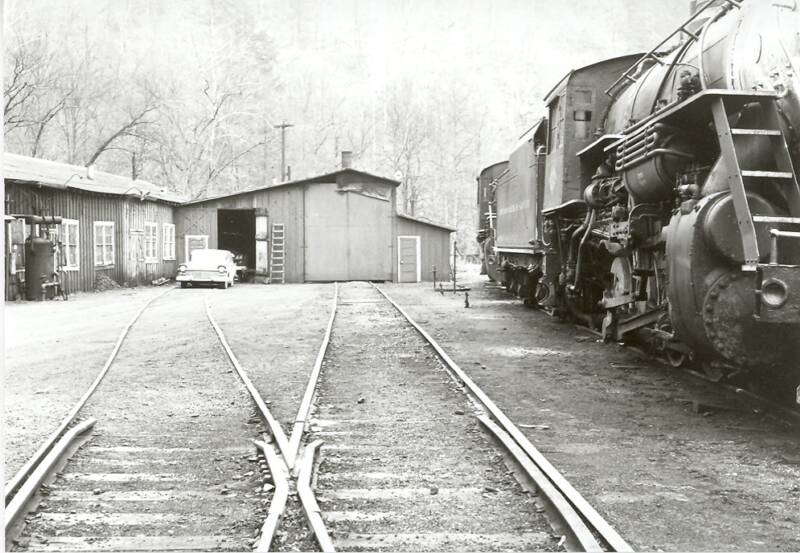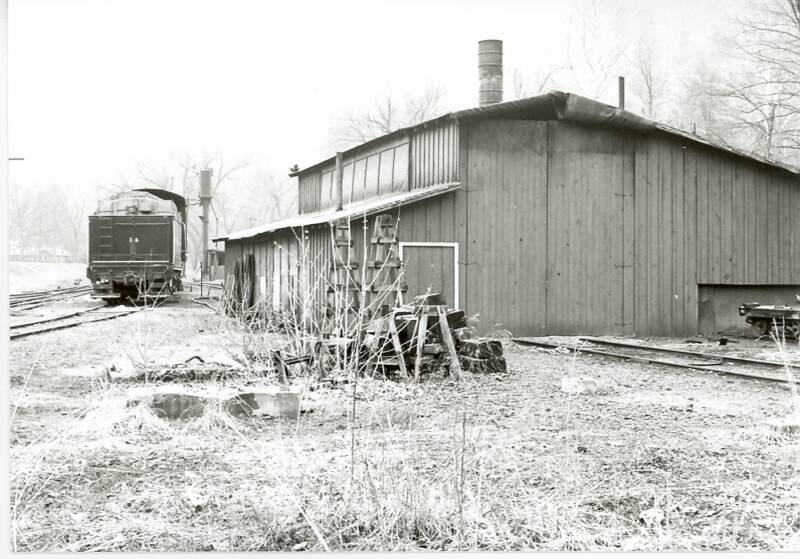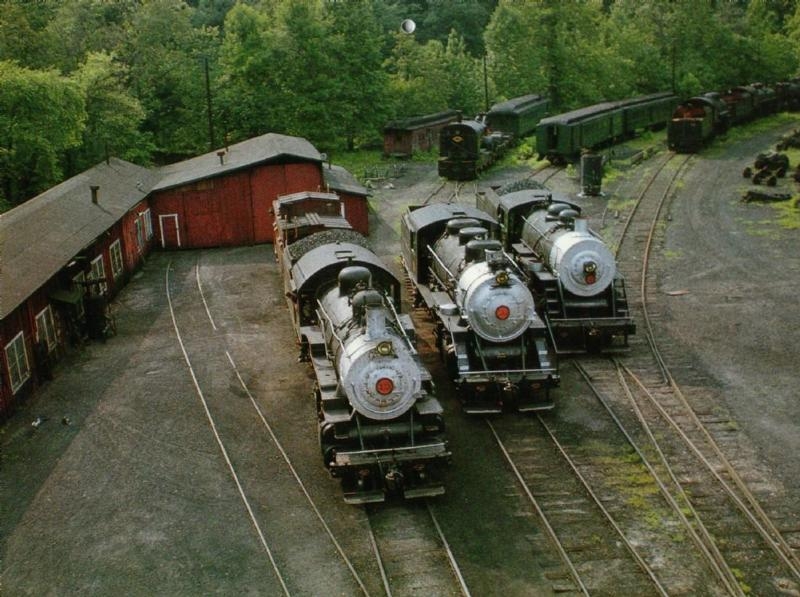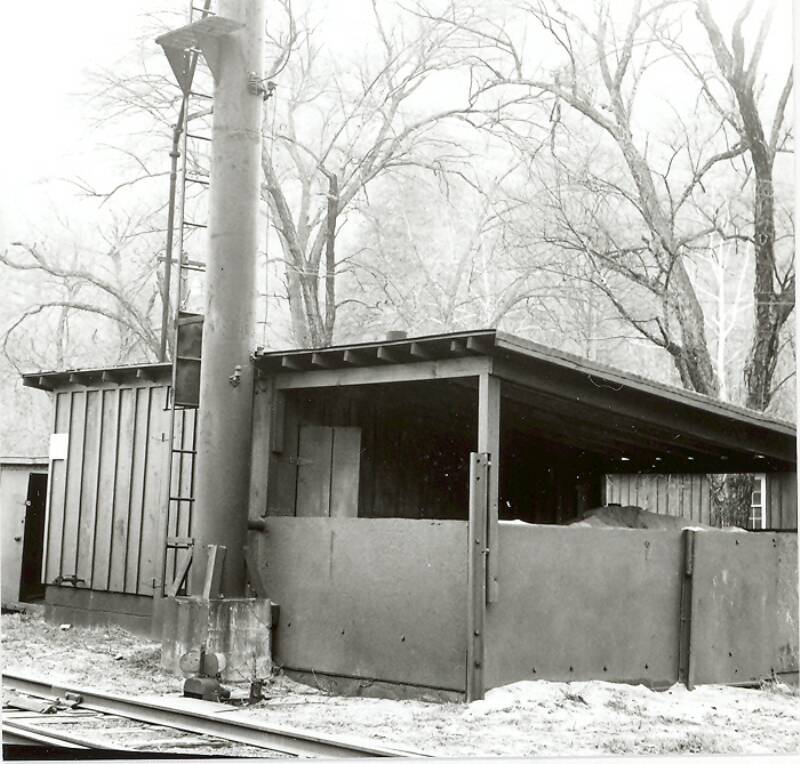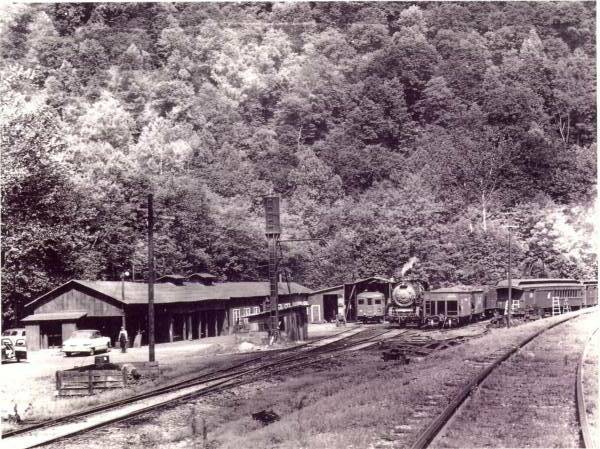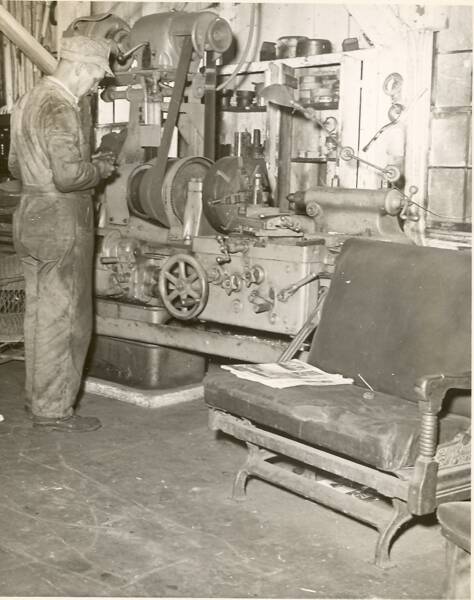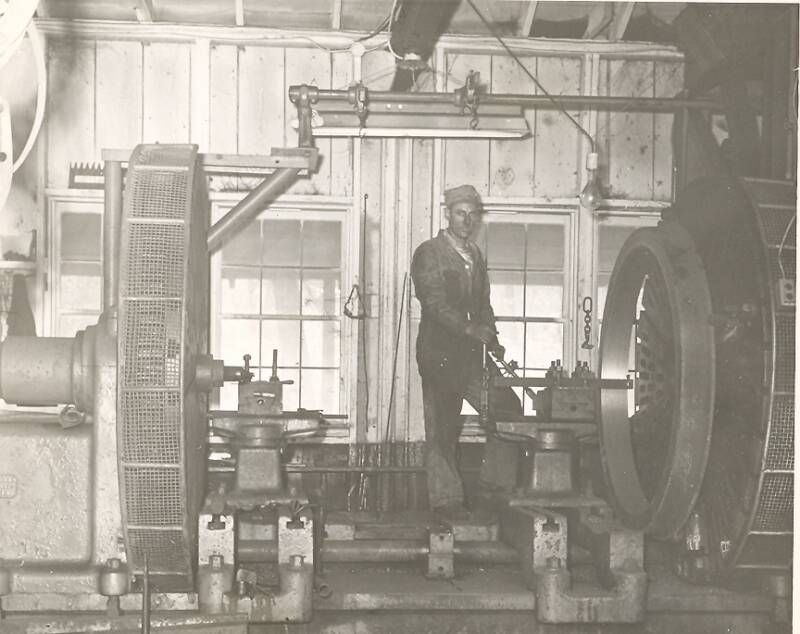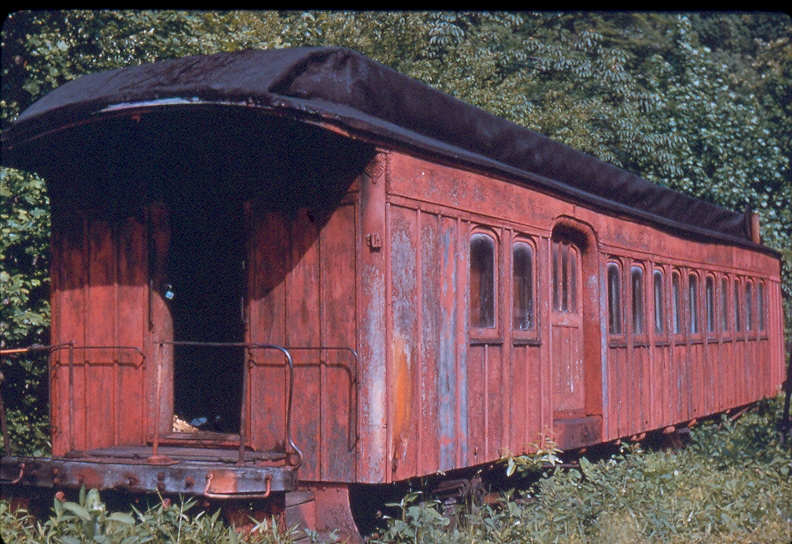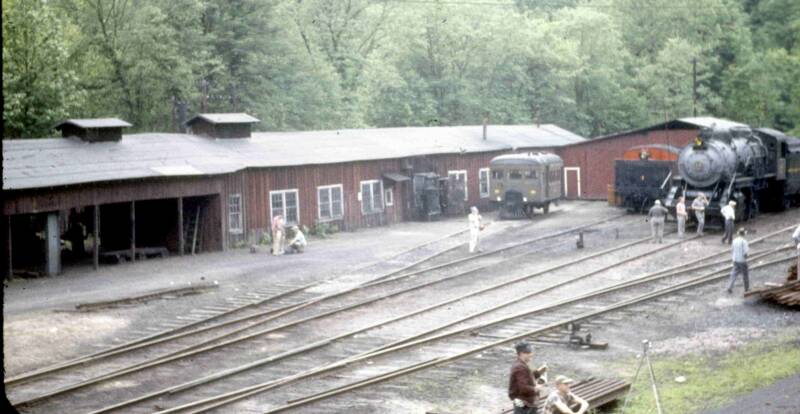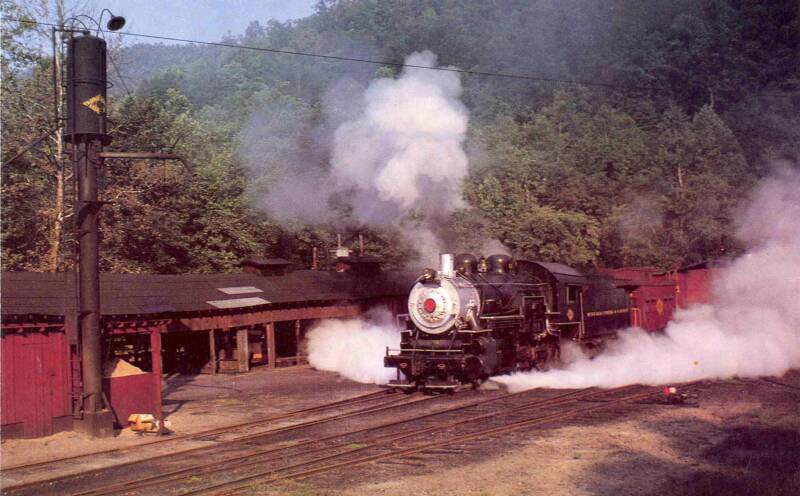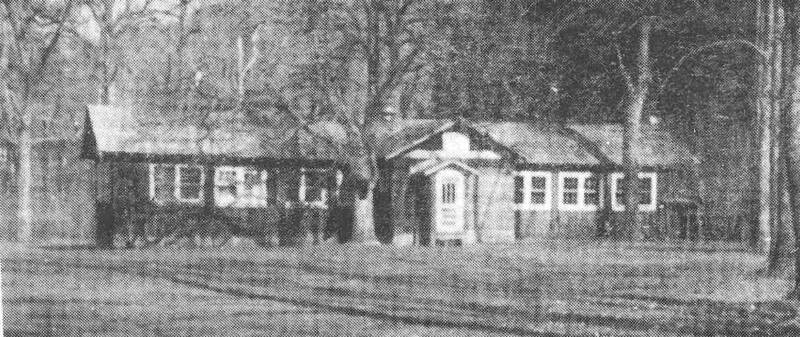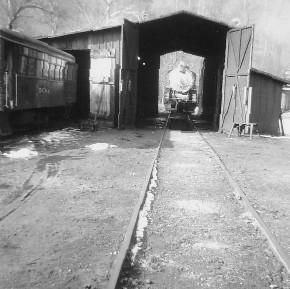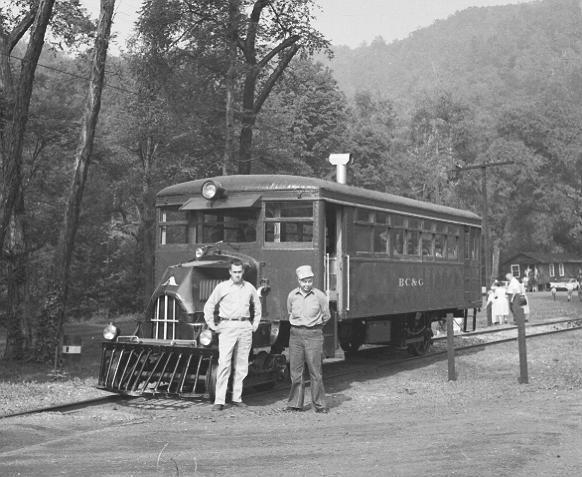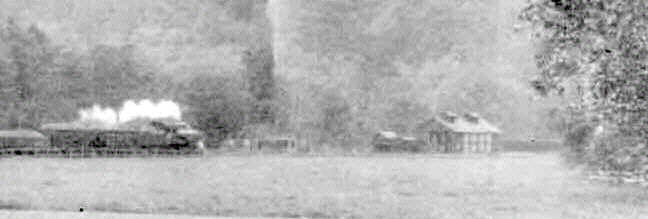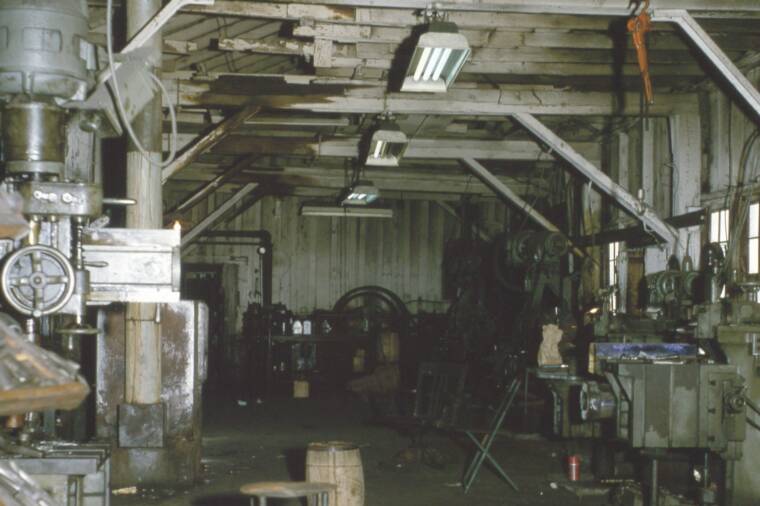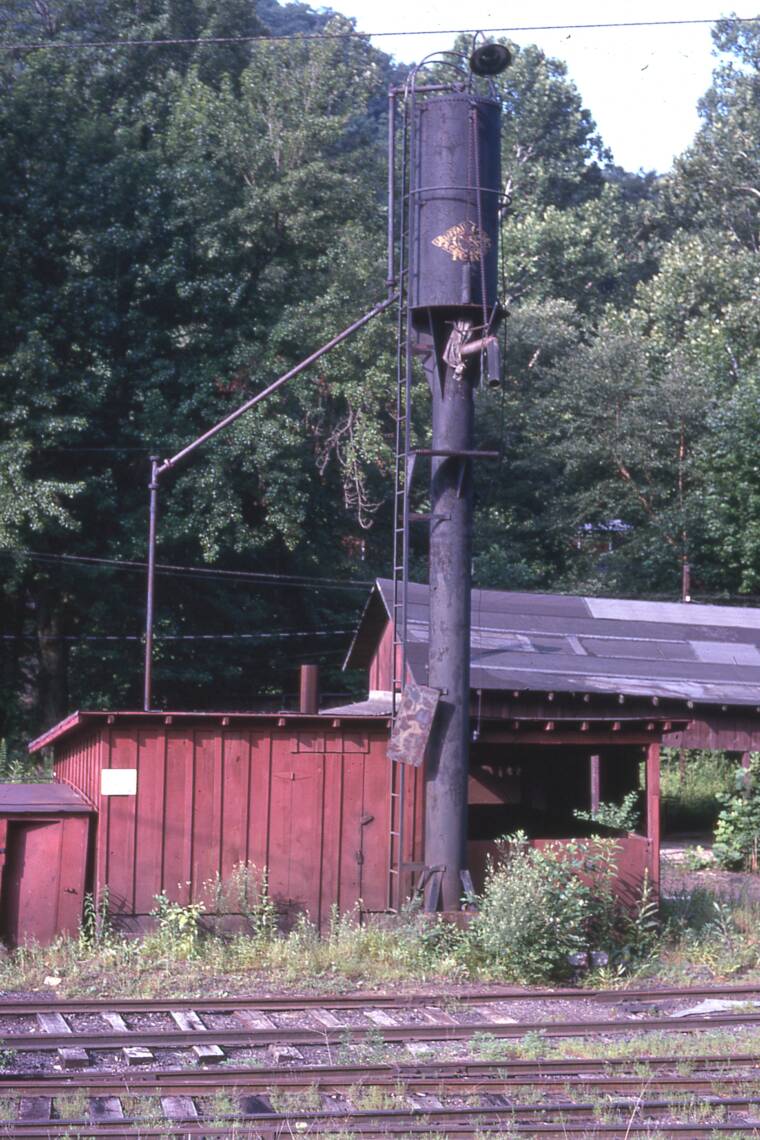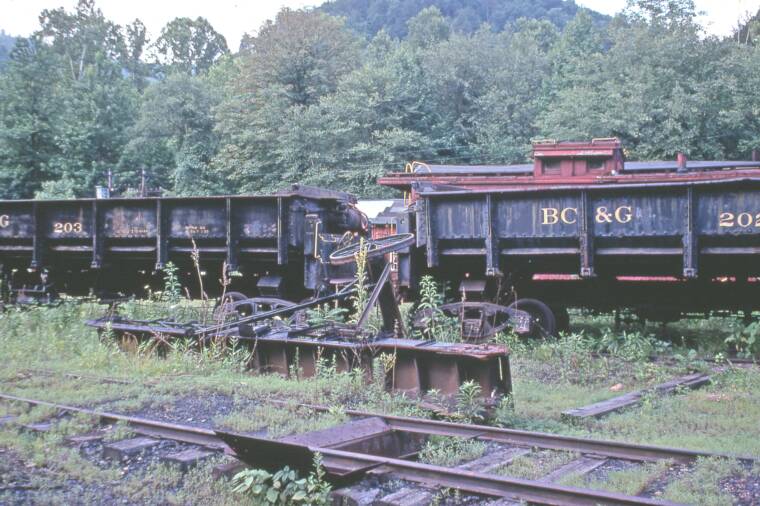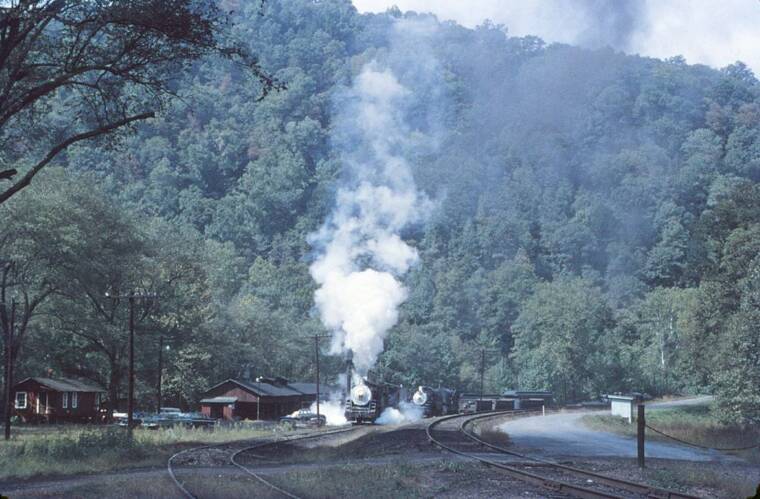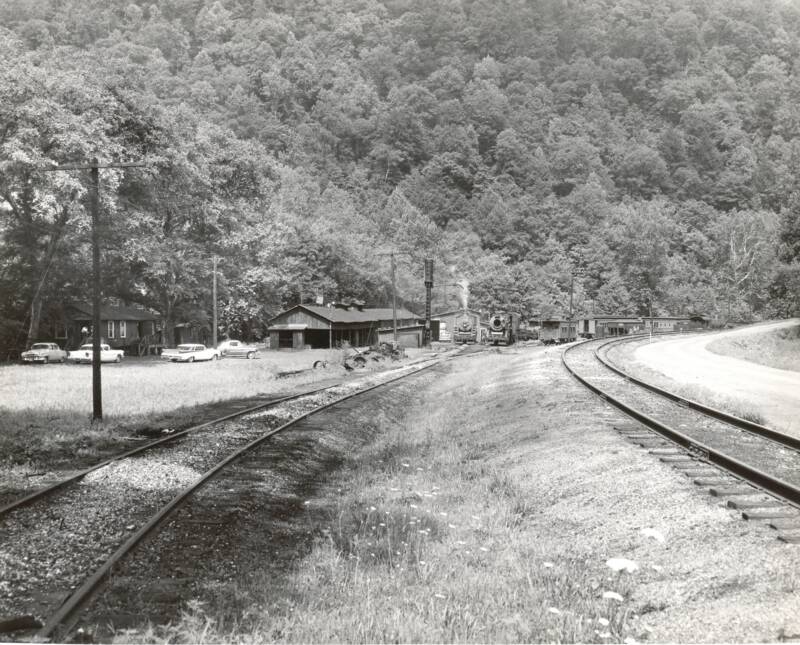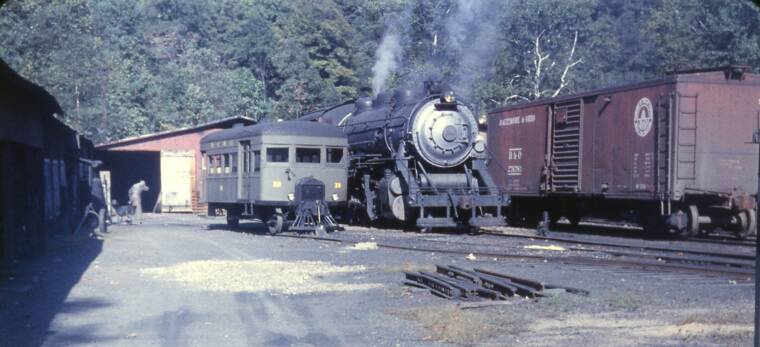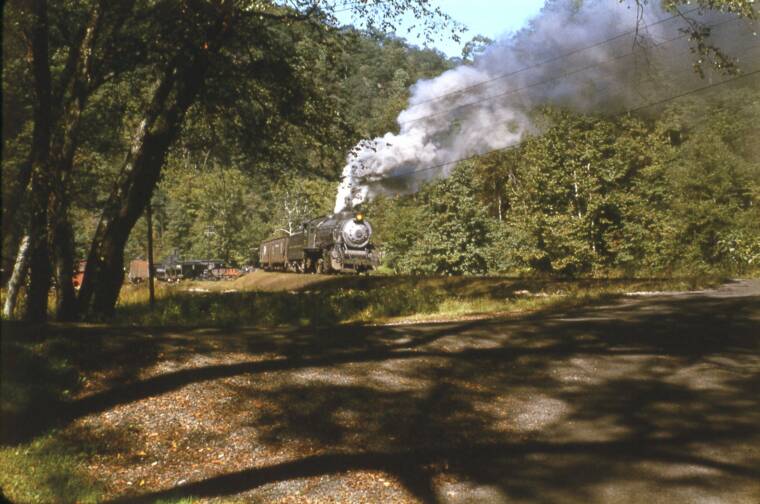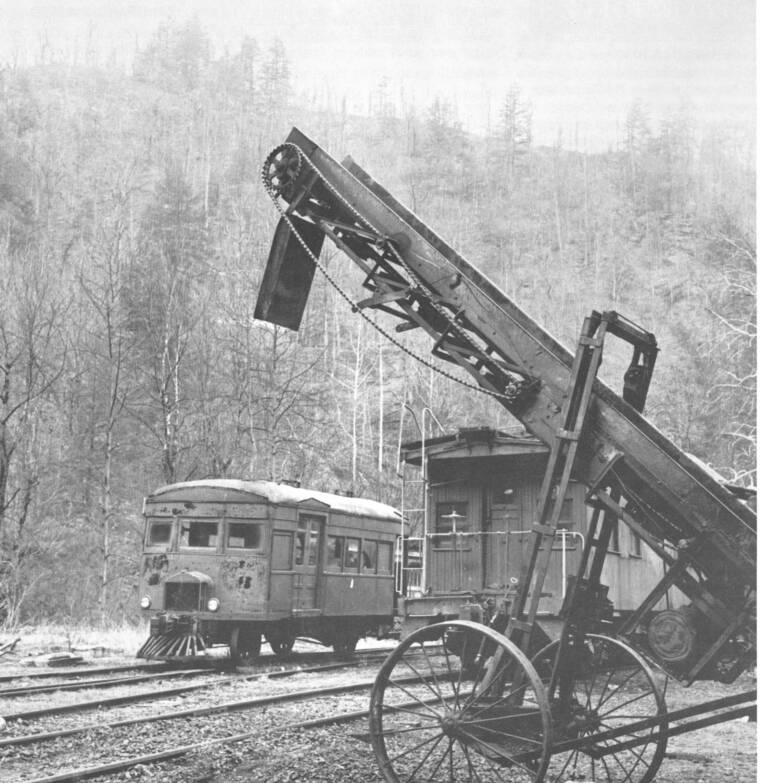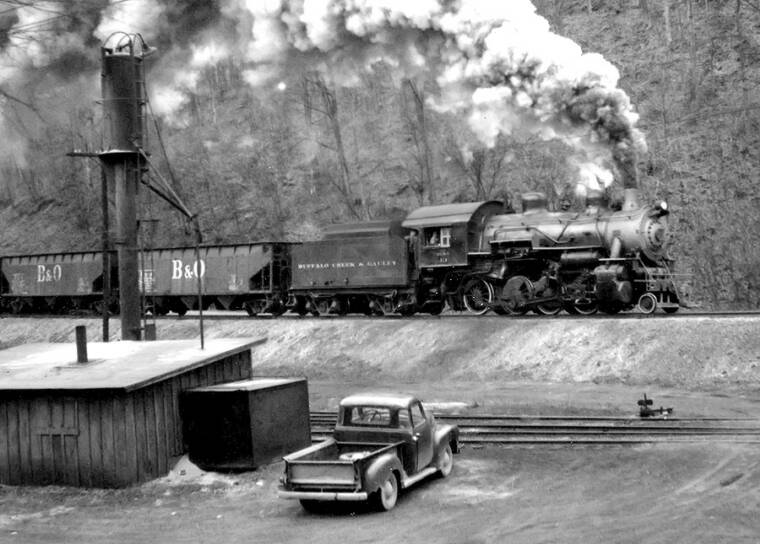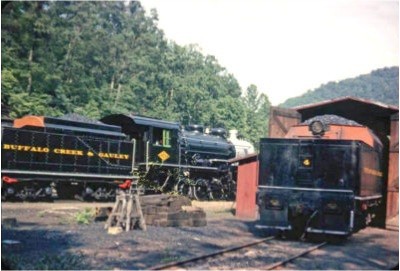Dundon Shops
This is an oft-published photo (left) taken from the top of the sand tower. It clearly shows the overall configuration of the tiny engine house. The Consolidations just barely fit under the roof and the engines were definitely longer than the engine house and could not be completely covered inside. The track entering the left side of the engine house in this view could accommodate the Railbus. Notice the pedestrian doorway that is in the larger access door has snappy white trim. This is the standard BC&G paint scheme - red with white trim.
According to the 1918 ICC Valuation Report the enginehouse measures 24' x 72' x 19.5'. It's not exactly clear just what part(s) of the building those dimesions apply to or whether this is even the same structure that existed in 1918.
The long building along the left is the machine shop and storage.
Overview of Dundon Shops - Bill Price July 1957
The Dundon shops were nestled along the Buffalo Creek. The hills rose steeply all around the yard. The sand house and tower is visible in the center of this 1957 photo that appears on page 13 of Warden's book.
There were three components to the sand house: the open sided sand pile, the enclosed sand house which contained a stove for drying the sand, and the sand tower.
Careful comparison of these two photos with the overview photo by William Price above on the right shows that apparently a new sandhouse was built sometime after 1957, probably in 1958 after the sale of the BC&G. The older house was to one side of the tower and looks to have had an uncovered sand pile. The new tower is "behind" the tower.
Photo by Jerry Hott , 1963
The two photos to the above by Jeff Madden are wonderful examples of photos taken by a modeler. Notice that someone wanting to build a model could literally place a protractor over the upper photo of the front of the engine house to duplicate the roof angles.
The lower photo isthe best one I've ever seen showing the back and this side of the engine house. It reveals that there were large windows along this wall. Notice that there appears to be no structure above the door opening. The smoke vent stack looks to be made from 55-gallon drums.
Engine House & Machine Shop
Sand House and Tower
Unknown photographer and date
Jeff Madden photo - circa 1965
The machine shop was very well equipped, including a wheel lathe and installation equipment. Even major maintenance was handled within the BC&G's own shops, a significant accomplishement for a small railroad.
David Marquis photo, circa 1960
Photo by Jerry Hott , 1963
These two similar photos above show additional details of the long storage shed including the interesting cupolas and the metal roof patches. In both photos the storage shed appears to be a slightly more brown color. The Hott photo shows the sand tower well.
Note the BC&G diamond logo on both engine #13 and the caboose. In neither photo does it look like the engines would fit under the roof of the engine house.
ERC&L Dundon Office
Photos by Jeff Madden, circa 1965
In the late 1950's this beautiful arch-window coach sat abandon in the yard. It's visible in the very back of the Hott photo at the top of this page. There is more information on this car in the ROLLING STOCK - Passenger Cars section.
This is the only photo I've seen of the entire yard office. It appeard in WIDEN, An Appalachian Emprie. It was near Mr. Bradley's residence and it's location is shown on the map on the DUNDON page. About 30 employees worked here recording the time people worked on the railroad. It is also here that passengers purchased train tickets
Photographer unknown
Sandra Ramsey photo
We are fortunate that Mr. Herald Baughman, who worked in the office, has provided this excellent description of the building and the activities that took place here:
"The main office of the Elk River Coal & Lumber Company and the BC&G Railroad Company was located at Dundon between the railroad maintenance shop and J. G. Bradley's house in a beautiful large lawn setting, bordered with trees. It was simply known and referred to as the "Dundon Office.
"The financial records of the companies were maintained here and were audited by a national accounting firm, at that time, named Lybrand, Ross Brothers & Montgomery. The "Paymaster" for the companies was located here and, in the 1953 era when production was at a peak, the payroll checks for about 900 miners at Widen were prepared in Widen, but were sent to the Dundon office to have a facsimile signature applied. The checks were then returned to Widen for distribution. A record of all coal cars coming in empty and going out loaded with Widen coal was recorded, first by a member of the train crew, and then was formally typed in a report prepared in the office.
"The office and the main entrance faced the shops, with a back door facing J. G. Bradley's house. A walk-in vault, secured by a combination lock, was located in the hallway just inside the entrance, on the right. Bathrooms were on the left of the hallway. The doors were located in the center of the building, dividing the office into two sections.
"Long-time officials were Elmer Bowyer who was in charge, Harold Boggess, Hobart Bower (of Bower Coal Sales), Earl Young and Robert "Bob" Johnson, along with other employees. Johnson was the dispatcher for the railroad traffic, directing when the trains and motor cars could travel to prevent collisions.
Herald Baughman - January 2008
Photo by Jeff Madden, circa 1965
Overall Setting
The photo above right clearly shows how the Dundon shops were situated between the BC&G main (on the right) and the Buffalo Creek (not visible to the left). The mountains appear to rise vertically behind the engine house and shop buildings.
Visible to the far left in the 1961 photo (yellow arrow) is a small yard office. It appears that Richard Manning had this building built when he became General Superintendent in 1959. This would have been shortly after the sale of the company. This small building appears in very few photos. One such photo is on the left. The yard office is behind Motor "A" at the right edge of the photograph.
Doug WIngfield photo - November 1961
Photo from Sigman collection
Abandoned Coach
Doug Bess photo - 1967
Oil Painting by Olesya Kline
Doug Bess, a railfan who visited the BC&G in 1967 and then again in 1972 has provided the two images above. The first was taken from almost the same spot as the photo from the Manning collection above right, just 8 years later after the BC&G was closed. Click to enlarge the image and you can see Motor 'A' in the engine house. Also just visible to the left is Manning's office. The image to the right is an oil painting by Olesya Kline, a cardiologist from Kazan, Russia. The painting was commissioned by Doug's wife who like the colors and majesty of the mountains. The painting now hangs in the Bess living room!
The Dundon Shops were located on the bank of the Buffalo Creek near where it joined the Elk River. Below is the earliest known photo of the area and what must be an engine house that pre-dates the one familiar to most BC&G fans from the later years. This is an enhanced portion of the panaoramic photo that includes Bradley's house. It certainly would be nice to know if those hoppers were two or three of the BC&G own units! It also appears there is some piece of equipment sitting in front of the engine house.
The Early Years
Thanks to Phil Bonzon for his help in extracting this portion of the image from the panoramic photo. I further enhanced it by increasing the contrast to make the engine house easier to discern. This photo dates from sometime in the early 1900s.
The interior of the machine shop was rarely photographed. The photo above was taken by John Killoran on the last day of operations, 12/31/65. Left to right seated: Master Mechanic Ralph Acree, Shopmen Carl and Riley Sears and hostler Bobby Caruthers. Car Inspector Raymond Poling who came down to spend the last day with his fellow workers is in the shadows on the far left.
John Phillips photo - 10-2-1958
Color photos of the interior of the machine shop are even rarer. The color photo of the interior above was taken in October 1958 by John Phillips on one his three trips to the railroad.
The photo on the left was taken by Robert Amon in August of 1963. Here's some great detail for a modeler to include in the interior of a model of the machine shop.
Richard Bradley photo - July 1969
Coal Pit & Loader
In 1969 Richard Bradley took these two photos of a small pit for transferring material from one of the sidings to another using a belt loader which can be seen laying on the ground.
In some photos a coal hopper or two can be seen sitting in this area of the yard, but none of those photos are conclusive about whether it was coal, ballast, sand or ashes that were dropped in the small pit between the rails.
In the undated photo on the left from the Vollrath collection the loader in its original configuration is clearly visible.
"Old" sand house configuration
(Inset photo from Richard Manning collection 1959)
This photo was taken by John Phillips in October 1958. While many photos show hoppers in the small yard at Dundon as well as the MOW equipment, few show box cars. Here, however, one is sitting right up at the front. It appears to be a B&O M-26 class. From a modelers perspective, it's beautifully weathered!
John Phillips October 1958.
This wonderful portrait of #14 coming off the interchange with empties was taken by John Phillips in October of 1958. The Dundon shops are just visible behind the trees on the left. This is approximately the view from the ERC&L Dundon Office.
John Phillips October 1958
This beautifully composed photo of #13 coming off the interchange shows perhaps the best view of the back of the 'new' sandhouse and excellent detail of the tower. The Chevy pickup looks posed specifically for the photo!
Photo from Rail Pictures collection - Tom Sink
I'm not sure where I obtained this photo, the date or photographer I've included it because it is the only one that I've seen that confirms that the small bay of the engine house may have been used specifically for the railbusses. Motor "A" can be seen sitting in front of the doorway.
For the modeler, there is also a good view of the detail of the inside door construction of the main doors of the engine house.
This photo gives a great idea of just how small the engine house was and how tight the clearance was to the locomotives! This undated photo was found on the internet but given the diamond logos was taken around 1962.
EMPLOYEES IN DUNDON SHOPS - by Roscoe Friend
Roscoe Friend, whose father worked in the shops in the 40s through the late 50s recalls that during that time they were at least five shop employees and a supervisor. The shop employees were Jim Friend, Willard Morris, Ralph Acre, Raymond Poling and Sam Caruthers (Bobby Caruthers father). Edgar Jones and then later R.E. Jackson served as supervisors. The supervisors did not do mechanical work but took care of assignments and paperwork. Thanks to Herald and Patsy Baughman for contacting Roscoe for this information.
